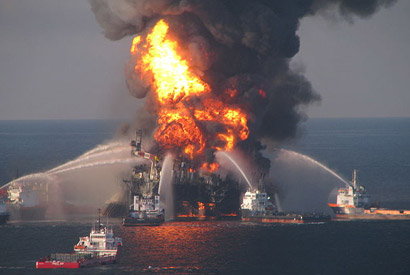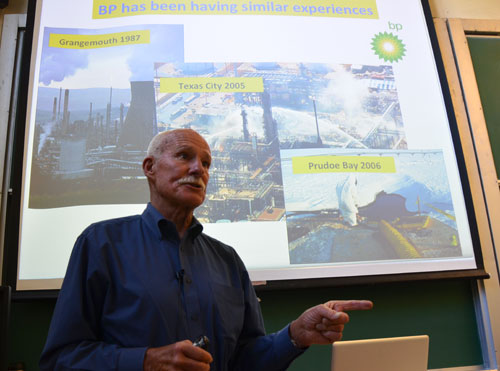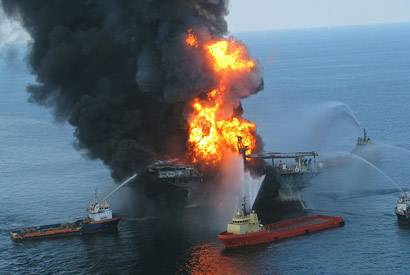Disaster expert cites ‘failure to learn’ for Deepwater Horizon blowout
Bob Bea, UC Berkeley professor of civil engineering and an internationally recognized veteran of disaster investigations, shared his assessment of the Deepwater Horizon blowout at an April 17 talk on campus. He called the event a "system disaster" that exemplified a "failure to learn" from past mistakes.

April 18, 2013
Nearly three years after the Deepwater Horizon catastrophe, UC Berkeley engineer Bob Bea still has vivid memories of the frantic phone call he received just moments before the oil rig exploded.
It was April 20, 2010, around 7:50 p.m. Bea recounted the woman saying, “Bob, listen to the radio! They’re screaming for mud!” The caller was referring to the panicked cries of workers on the Deepwater Horizon oil rig trying to contain an uncontrolled flow of water, oil, mud and gas from the Macondo well, about 5,000 feet below the surface of the Gulf of Mexico.

UC Berkeley engineer Bob Bea, an expert witness in the ongoing Deepwater Horizon trial, calls the Gulf oil spill a “system disaster.” (Sarah Yang photo)
The caller, who knew Bea from his investigation of the New Orleans levee failures during Hurricane Katrina, was in Louisiana, monitoring VHF channel 16, the radio frequency reserved for maritime emergencies.
Moments after Bea got off the phone, two explosions and a merciless fire would result in 11 deaths and the largest offshore oil spill in U.S. history. By the time BP capped its well 87 days later, some 4.9 million barrels (206 million gallons) of oil had spewed into the Gulf.
“We blew it up good,” said Bea, recounting the disaster this week before a roomful of academics, professional engineers and students at UC Berkeley. The audience members had gathered Wednesday (April 17) to hear Bea talk about his investigation into the Deepwater Horizon disaster. The talk was sponsored by the campus’s Center for Catastrophic Risk Management, an interdisciplinary group of researchers and practitioners co-founded after Hurricane Katrina by Bea, professor emeritus of civil and environmental engineering, and Karlene Roberts, professor emeritus at UC Berkeley’s Haas School of Business.
In 2002, Bea and Roberts authored a report for BP identifying organizational challenges within the global oil company after a series of acquisitions. Bea is now an expert witness in the ongoing federal trial to determine the level of liability of defendants BP, Transocean and Halliburton in the Gulf oil spill.
The first phase of the trial, which focused on events leading up to the blast, wrapped up April 17 in New Orleans. The trial’s second phase, scheduled to begin in September, will move on to the explosion and efforts to mitigate its resulting damage. The trial, which is expected to continue into 2014, could result in dramatically increased fines for the defendants.
Bea, an internationally recognized veteran of disaster investigations, has taken part in dissecting the 1988 Piper Alpha oil platform explosion in the North Sea, the 1989 Exxon Valdez oil tanker spill in Alaska’s Prince William Sound, the 2003 disintegration of Space Shuttle Columbia and the 2005 levee failures in New Orleans.
“There is one common thread to these disasters,” Bea said. “They are system disasters. They’re caused by human and organizational malfunctions.”
And, too often, they occur because there is a “failure to learn” from past mistakes, Bea said.
Bea’s assessment of what went wrong with Deepwater Horizon has been well documented both at trial and in media interviews. At his UC Berkeley talk, Bea pointed out that BP had adopted an Operating Management System that outlined a zero-tolerance approach to ensure safe, healthy and environmentally sound practices at its facilities. But the system was in place at only one of the seven drilling rigs operated by BP in the Gulf of Mexico — the one it owned, Bea continued. The other six rigs, including Deepwater Horizon, were leased from other companies.

Multiple Coast Guard helicopters, planes and cutters responded to rescue the Deepwater Horizon’s 126 person crew. (U.S. Coast Guard photo)
BP “exempted some of the riskiest sites that they knew” from following its safety system, said Bea. “They (BP directors) decided they couldn’t spend the time and money and effort; they would rely on the contractors to take care of those safety things.” (The outsourcing of expertise also plagued the U.S. Army Corp of Engineers when building the levees that failed in Hurricane Katrina, Bea pointed out.)
In addition to delegating responsibility for safety, BP worked under a global mantra of making sure “every dollar counts,” emphasizing reduced costs and increased productivity, Bea said. At the time of the blowout, the Deepwater Horizon rig was over budget by $60 million and more than 60 days behind schedule.
“They had gotten so lean and mean, they were falling over,” said Bea.
The same values — depending on consultants and outsourcing for the sake of efficiency — are emphasized in many business classes, an audience member said, who advocated for the development of a culture of learning from past mistakes.
Bea added that the systemic problems extend beyond corporations to government and regulatory agencies in the United States. He cited the near-failing grade of America’s infrastructure given last month by the American Society of Civil Engineers.
“The United States is the richest, most powerful country in the world,” said Bea after the talk. But such success can also lead to hubris and complacency when it comes to tasks like shoring up the country’s infrastructure.
There are, he said, some industries that are setting a better example when it comes to risk and safety, the commercial nuclear power and the aviation industries among them.
“Those industries have a very clear unifying goal: Don’t kill anybody,” said Bea.
RELATED INFORMATION
- Deepwater Horizon Study Group (Links to reports and testimony)
- Center for Catastrophic Risk Management